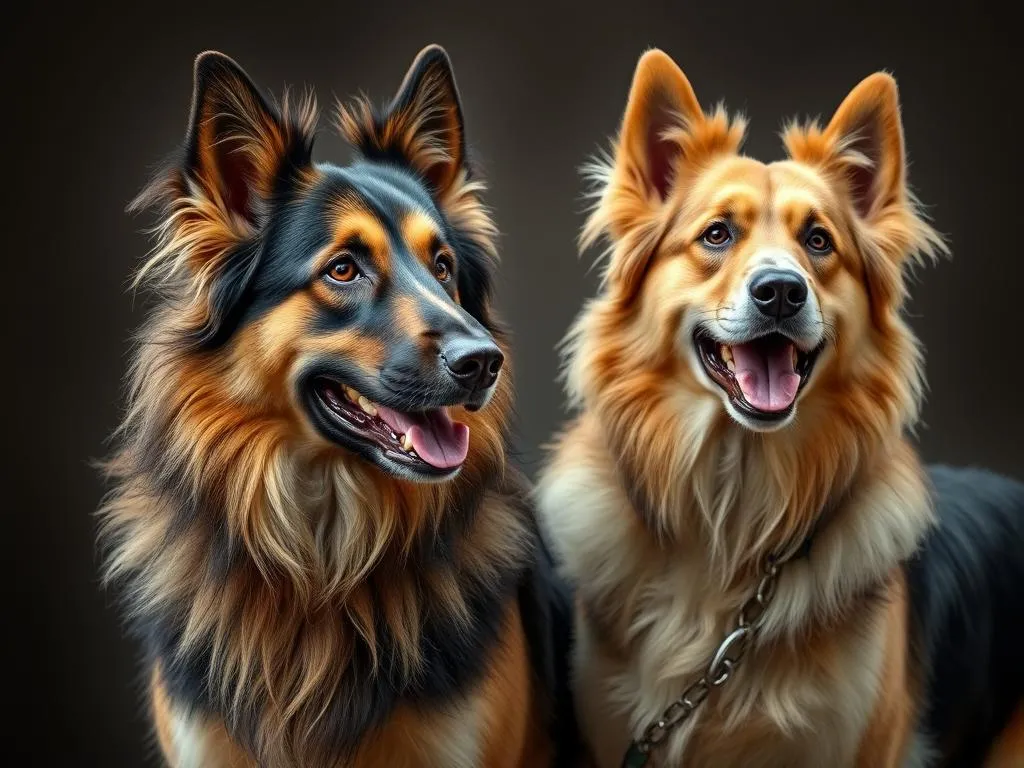
Introduction
Shepherd dog breeds are a diverse group of dogs originally bred for herding livestock. These breeds have been influential throughout history, serving not only as working dogs but also as beloved companions. Their origins can be traced back to various regions of the world, where they were developed to assist farmers and shepherds in managing their flocks.
The importance of shepherd dogs extends beyond herding. They have taken on roles in search and rescue, police work, and service animals, showcasing their versatility and intelligence. Their strong instincts, loyalty, and protective nature make them ideal companions for families, singles, and seniors alike. In this article, we will explore some popular shepherd dog breeds, their characteristics, and their care needs.
Characteristics of Shepherd Dog Breeds
Physical Traits
Shepherd dog breeds typically share several physical traits. While size and weight can vary significantly among different breeds, they generally fall into the medium to large size category. Most shepherds weigh between 50 to 90 pounds, depending on the specific breed.
Regarding coat types, shepherd dogs can have short, medium, or long fur, often featuring a double coat for protection against the elements. Colors can range from solid black, brown, and gray to a mix of patterns and shades. Distinctive features often include erect ears, bushy tails, and a strong, athletic build that supports their active lifestyles.
Temperament
The temperament of shepherd dog breeds is one of their most appealing traits. These dogs are known for their intelligence, loyalty, and protectiveness. They are eager to please and often form strong bonds with their families. This makes them suitable for a variety of living situations, including homes with children, singles, or seniors.
However, it’s important to remember that each breed may have unique personality traits. For instance, some may be more independent, while others thrive on companionship and interaction.
Energy Levels and Exercise Needs
Shepherd dog breeds are generally high-energy dogs, requiring regular exercise to keep them physically and mentally stimulated. Most shepherds benefit from at least 1 to 2 hours of exercise each day, which can include walks, playtime, and training sessions. Engaging in activities like agility training or herding trials can be particularly rewarding for these breeds, allowing them to utilize their natural instincts while bonding with their owners.
Popular Shepherd Dog Breeds
German Shepherd
The German Shepherd is perhaps the most recognized of all shepherd dog breeds. Originating in Germany in the late 19th century, this breed was developed for herding and protecting sheep. Known for their intelligence and versatility, German Shepherds excel in various roles, including police and military work, search and rescue, and as service dogs.
Key characteristics of German Shepherds include their strong, muscular build, erect ears, and a dense double coat that can be black and tan, sable, or all black. They are known for their protective nature, making them excellent family pets as well as watchdogs. Common health issues in German Shepherds include hip dysplasia and degenerative myelopathy, so regular check-ups and a healthy diet are crucial for their care.
Belgian Malinois
The Belgian Malinois is another prominent member of the shepherd dog breeds family. This breed is often mistaken for the German Shepherd due to its similar appearance, but it is slightly smaller and lighter. Originally bred for herding in Belgium, the Malinois has gained fame as a working dog, particularly in law enforcement and military roles.
With a high energy level and strong drive to work, Belgian Malinois require thorough training and socialization. They thrive in environments where they can engage in physical activities and mental challenges. To keep them happy and well-adjusted, owners should focus on obedience training and socialization with other animals and people from a young age.
Australian Shepherd
The Australian Shepherd is a breed that, despite its name, was developed in the United States. Known for their intelligence and agility, Australian Shepherds are outstanding herding dogs. They have a unique appearance, with a striking coat that can be merle, solid, or a combination of colors, and often have distinctive facial markings.
Australian Shepherds are highly energetic and require significant exercise and mental stimulation. Activities such as agility training, obedience competitions, and herding trials keep them engaged. Regular grooming is necessary due to their thick coat, which can mat if not maintained properly.
Shiloh Shepherd
The Shiloh Shepherd is a relatively new breed that was developed in the 1970s to create a larger, gentler version of the German Shepherd. This breed retains many of the German Shepherd’s desirable traits, including intelligence and loyalty, while being known for their calm demeanor.
Shiloh Shepherds are well-suited for families and require ample exercise and socialization. They thrive in environments where they can be part of the family dynamic. Compared to German Shepherds, Shilohs tend to be more sociable and patient, making them excellent companions for children and other pets.
Anatolian Shepherd
The Anatolian Shepherd is a unique breed developed in Turkey primarily for livestock guarding. Their role as a livestock guardian requires them to be independent and protective, making them steadfast defenders of their flocks.
Anatolian Shepherds are large, powerful dogs with a strong instinct to protect their territory. They require proper training and socialization to ensure they can differentiate between friend and foe. Their exercise needs are moderate, as they often prefer to patrol their surroundings rather than engage in vigorous play.
Training and Socialization for Shepherd Dogs
Importance of Training
Training is crucial for all shepherd dog breeds. Early training helps to establish a strong bond between the dog and owner and can prevent behavioral issues later on. Positive reinforcement methods, such as treats and praise, are highly effective in motivating these intelligent breeds.
Common training methods include obedience training, which teaches basic commands, and specialized training for specific roles (e.g., service work, search and rescue). Consistency is key, as shepherds respond well to structured routines.
Socialization Techniques
Socialization is another vital component of raising a healthy, well-adjusted shepherd dog. Exposing them to various environments, people, and other animals from a young age helps them develop confidence and adaptability. Puppy classes can be an excellent way to facilitate socialization while providing training.
Common Behavioral Issues
While shepherd dog breeds are generally well-behaved, they can exhibit specific challenges. For instance, their herding instincts might lead to nipping or chasing behavior. Additionally, their protective nature can result in excessive barking or wariness around strangers. Addressing these issues often requires patience, consistent training, and sometimes the guidance of a professional trainer.
Health Considerations for Shepherd Dog Breeds
Common Health Problems
Shepherd dog breeds are prone to certain genetic disorders. Hip dysplasia is common among larger breeds, leading to joint problems and arthritis. Other health issues may include degenerative myelopathy and certain heart conditions. Regular veterinary check-ups, a balanced diet, and proper exercise are essential for monitoring their health.
Regular Health Care
Routine health care is crucial for maintaining the well-being of shepherds. Regular check-ups and vaccinations help catch potential health issues early. A nutritious diet tailored to the specific needs of the breed and age can support their overall health and longevity.
Preventive Measures
To maintain health, owners should focus on preventive measures such as regular exercise to keep weight in check, dental care to prevent periodontal disease, and grooming to avoid skin issues. Establishing a routine with these practices can lead to a happy, healthy life for your shepherd dog.
Living Arrangements for Shepherd Dogs
Ideal Home Environment
Shepherd dog breeds thrive in environments that allow them space to move and explore. While they can adapt to various living situations, a home with a yard is ideal. Urban settings can work, but regular access to parks or open spaces is necessary for exercise.
Companion Activities
To engage shepherd dogs, owners can explore various activities such as agility courses, obedience training, and herding trials. These activities stimulate both their physical and mental needs, promoting a balanced and happy lifestyle.
Family Integration
Introducing a shepherd dog to a family can be a rewarding experience. Gradual introductions to children and other pets help foster positive relationships. Creating a balanced environment by establishing rules and routines benefits both the dog and family members, ensuring harmony in the household.
Conclusion
In summary, shepherd dog breeds are a remarkable group of dogs that offer loyalty, intelligence, and versatility. Their unique characteristics and strengths make them suitable for various roles, from family companions to working dogs. Understanding the specific needs and traits of each breed can lead to a fulfilling experience for both the dog and the owner.
When considering adding a shepherd dog to your life, it’s essential to research the breed that best fits your lifestyle. Whether you choose a German Shepherd, Belgian Malinois, or any other breed, the connection you’ll build is sure to be a rewarding journey.
By investing time in training, socialization, and care, you can ensure your shepherd dog thrives and becomes a cherished member of your family.









